First things first: CD for sale! Remember the Luis Gasca album, For Those Who Chant, that I wrote about last week? Well, I have an extra copy of the CD, brand new and still sealed. (I ordered one, the Postal Service lost it, I ordered another, and the first one turned up after all.) If you want it, I’ll sell it to you for $25 plus shipping. Drop me an email at burningambulance@gmail.com.
I’m back to writing reviews for Shfl. My first batch is core curriculum: Chuck Berry, Bo Diddley, Little Richard, and Louis Jordan. If you don’t know, now you know.
Jeff Beck died, and I had never paid much attention to his music. Many years ago, I heard his first two albums, the ones people always say “they could have been as big as Led Zeppelin!” about, and you know what? No, they could not have been, and not just because Rod Stewart was their singer. (Rod Stewart sucks. I will not debate you on this. Whatever “oh, but you’ve got to hear…” you’ve got in your pocket, trust me, I’ve heard it, and it sucks.) But this week, I listened to the four instrumental albums Jeff Beck released in the ’70s — Blow by Blow, Wired, Live with the Jan Hammer Group, and There and Back — and they’re all really good! They remind me of contemporaneous albums by Stanley Clarke (no surprise there, as Beck played on Journey to Love and Modern Man), Jean-Luc Ponty or Al Di Meola: complex funk, loads of shredding, wiggy prog synths, occasional Latin rhythms. The live album is probably my least favorite, but I will be listening to them all again in the future.
Let’s talk about drone music. I don’t listen to a lot of it, because I have pretty noticeable tinnitus anyway, and when I’m listening to the same note for a long time, the note my damaged ears produce often decides to join the party too. But sometimes I’m in the mood, and right now, there’s a lot of really good drone stuff coming out, so I’ve been slapping on my new Sony MDR-7506 headphones, which I wholeheartedly endorse, by the way, and letting my skull vibrate for a while.
Organist Kali Malone has just released a 3LP or 3CD set, Does Spring Hide Its Joy. It’s a collaboration with guitarist Stephen O’Malley (Sunn O))), KTL, Khanate, etc.) and cellist Lucy Railton and consists of two or three (depending on your format of choice) hour-long drone pieces — variations of the same piece, actually. This music really needs to be heard digitally, though. Splitting each of the first two pieces into three sections each, with edits, to get them onto vinyl feels to me like it would wreck the whole mood they’ve worked so hard to create. I’ve been listening to Malone for a few years now; I read a Philip Sherburne review of her 2019 3CD set of church organ improvisations, The Sacrificial Code, bought it, and loved it. On Does Spring Hide Its Joy, she’s playing 72 tuned sine wave oscillators while Railton plays cello and O’Malley plays guitar (don’t expect any Crushing Doom Riffs, though). The whole thing comes together into an oceanic endless-seeming flow of tones layered together, with occasional genuinely vivid interactions. At its most active, it reminds me of Tony Conrad and Faust’s Outside the Dream Syndicate, but drumless. I was sent a promo download of this, but liked it enough to buy the CD version. Highly recommended.
Composer Ted Reichman also has an album of organ music out this week, sort of. The genesis of Orgelwerke was a stack of organ LPs he grabbed from a library’s discard box. He began to pluck chunks of the music out, turn it into digital loops, then warp and process and recontextualize it into new pieces. The four tracks on the CD run between seven and 12 minutes, and they have a kind of William Basinski meets Thomas Köner meets Angelo Badalamenti’s-Eraserhead-soundtrack quality. The tones fade slowly in, and hover in a kind of glimmering but also gradually disintegrating cloud. There are multiple layers of things all happening at once, so it’s like being surrounded by organ players at times, and each track builds to a kind of ecstatic crescendo before washing away like the tide going out. If you play this loud enough, it’ll probably shake your speakers off the shelf.
Queen of drones Éliane Radigue has an archival release, 11 Dec 1980, coming out next month on Important Records. It’s a two-CD set preserving a live performance on the San Francisco radio station KPFA. She plays Chry-ptus and her Tryptych in full; this performance marked the world premiere of Parts I and III of the latter piece, though Part II had been performed before. Chry-Ptus, which runs 24 minutes, was Radigue’s first piece for modular synthesizer, and it’s much more active than other stuff I’ve heard by her. It has a literal ticking rhythm running through much of it, and even when that’s absent, there’s still a pulse. Other notes come in and out, floating around and hovering and sometimes getting quite loud and insistent; it reminds me of pieces I’ve heard by Conrad Schnitzler. The three movements of Tryptych, which last just over an hour, are focused on low-end drones, gonglike resonations, and steady hums; it’s a cross between the chilly early ’90s work of Thomas Köner and an imaginary soundtrack to a sci-fi movie set in a science lab gone wrong, like Phase IV. What’s really interesting about 11 Dec 80 is that — maybe because it was originally a radio broadcast — there’s a layer of ambient static and hiss throughout. I feel like this music would register differently if it was preserved with pristine digital clarity, and total silence except for the electronic tones, but it might not be as unexpectedly emotionally affecting as it is.
That’s it for now. See you next week!





